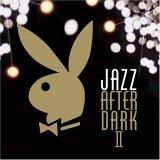
Various Artists
JAZZ AFTER DARK II
Playboy Jazz
This second volume in the series continues the tradition by offering a two-disc set of jazz ballads performed by an all-star collection of artists that spans almost 50 years from 1953 to 2001. The discs are divided up into an instrumental disc and a singers disc.
Disc 1 gets your attention right away by beginning with an amazing track that unites three legends of jazz. Sonny Rollins plays with the Modern Jazz Quartet on Duke Ellington’s “In a Sentimental Mood”. They create such a smooth sultry sound together that you shouldn’t be surprised if you feel a compulsion to go buy Sonny Rollins with the Modern Jazz Quartet.
Next up are Cannonball Adderly and Bill Evans who front a quartet. Their leads capture the poignancy that a “Goodbye” can bring. Many artists on this disc follow this same tried-and-true musical template. Coleman Hawkins and Tommy Flanagan trade leads on Jerome Kern and Otto Harbach’s classic “Smoke Gets in Your Eyes”. Hawk’s sax solo is the usual transcendence that we’ve come to expect from him. “Come Rain or Come Shine” is an upbeat declaration of love by Art Pepper and Dolo Coker. Dave Brubeck and Jerry Bergonzi share duties on Mercer and Van Huesen’s “I Thought About You”. Marian McPartland, who Brubeck considered one of the top three best pianists of all-time, is joined by tenor sax player Chris Potter on “What’s New”.
This disc closes out with an all-star combination equal to the one it began with. Thelonius Monk and John Coltrane perform what is arguably the quintessential version of Monk’s ballad, “Ruby, My Dear”. One of the highlights of the track is the brushwork of Shadow Wilson on drums. This is one of three songs recorded by this quartet, which is completed by bassist Wilbur Ware.
Slight variations to the formula occur. On “I Fall in Love Too Easily”, The Gene Harris/Scott Hamilton Quintet includes Herb Ellis on electric guitar, whose solo is as radiant as the prospects of love. Ellington performs his “All Too Soon” and adds the swinging muted trumpet of Cat Anderson.
But ballads are more than piano-sax combos. The immediately recognizable tones of Miles’ Harmon-muted trumpet leads “When I Fall in Love”, a track from Steamin’ with the Miles Davis Quartet. Pianist Red Garland contributes a good solo. “Emily” is performed by piano-guitar duet George Shearing and Jim Hall. Chet Baker expands to a sextet, which includes the flute of Herbie Mann.
Disc 2 makes it immediately clear that there will be no let up in star power. It opens with Tony Bennett singing Rodgers and Hart’s “My Romance.” His gifted voice is a match for any man’s talents on an instrument. Sarah Vaughn is backed by pianist Oscar Peterson and guitarist Joe Pass on “Easy Living”. Rosemary Clooney pays tribute to Billie Holiday with “Lover Man (Oh Where Can You Be?)." Abbey Lincoln is backed by bassist Wynton Kelly, drummer Max Roach and Sonny Rollins, who comes in at the bridge and adds some touches at the end. It’s a marvelous performance by all and a highlight of the entire set.
Some of the singers put their vocals on full display by being accompanied by a lone instrument. Pianist George Shearing returns backing Carmen McRae on “If I Should Lose You.” Patti Austin repeats the formula, singing the Gershwins’ “The Man I Love.” Peter Cincotti accompanies himself on piano.
Ella Fitzgerald is backed by guitarist Joe Pass, who makes his second appearance on this disc, on Ellington’s third composition to appear in the set, “I Didn’t Know About You.” Ella has been dubbed “The First Lady of Song” and it’s certainly obvious on this track. Her voice is so beautifully melodic that I found myself disappointed as Pass performed the bridge and I had to wait for her to return.
Jazz After Dark II is a great selection for lovers of jazz and for those new to it, it’s a great place to start. While Disc 1 leans heavy on jazz legends of the past, Disc 2 is evidence that the jazz-singing tradition is in the capable hands of artists, new and old, like Curtis Stigers, Patti Austin, Diane Schur, and Nnenna Freelon.
The subtle differences in the artists’ approaches are on display, but that’s not to say that the music is cerebral. These songs are meant to evoke emotions and remembrances of love. It’s a very good listen by yourself and it’s even better with the right company.
